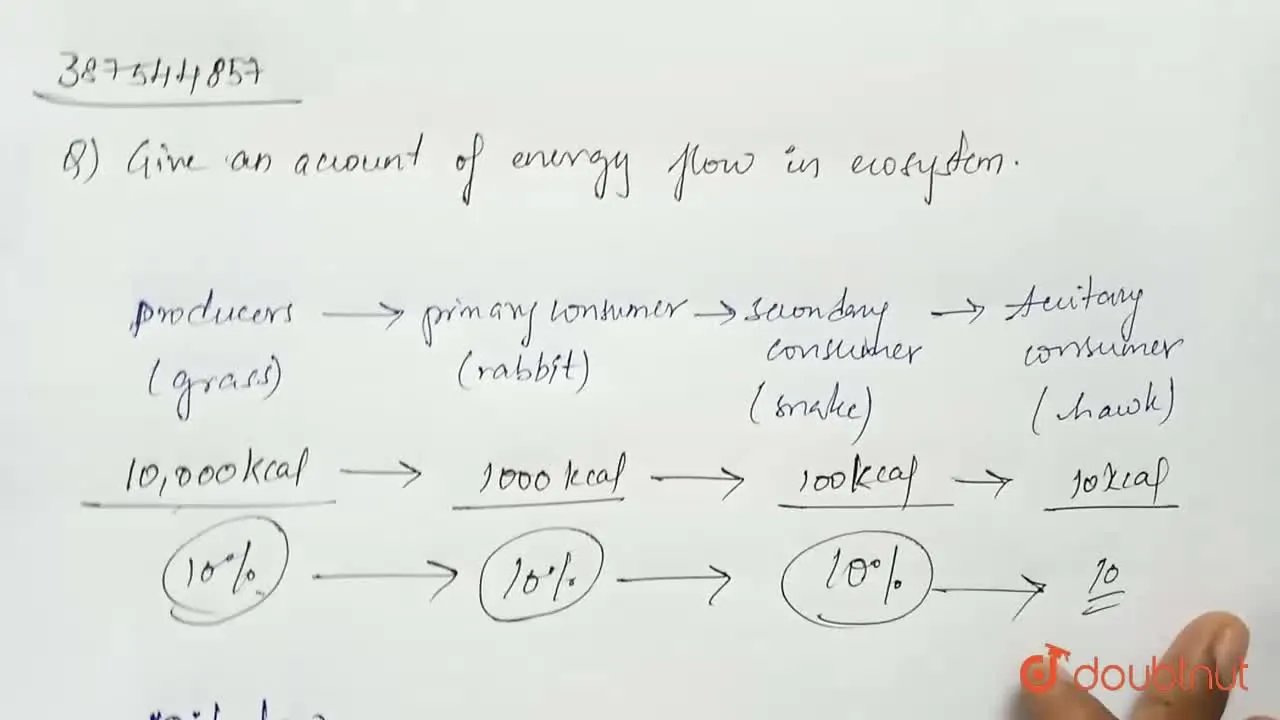Give an account of energy flow in an ecosystem.Solution in Telugu
Except for the deep sea hydro-thermal ecosysteň, sun is the only source of energy for all ecosystems on Earth. Of the incident solar radiation less than 50 percent of it is photosynthetically active radiation (PAR). We know that plants and photosynthetic bacteria (autotrophs), fix sun.s radiant energy to synthesise food from simple inorganic materials. Plants capture only 2-10 percent of the PAR and this small amount of energy sustains the entire living world. So, it is very important to know how the solar energy captured by plants flows through different organisms of an ecosystem. All heterotrophs are dependent on the producers for their food, either directly or indirectly. The law of conservation of energy is the first law of thermodynamics. It states that energy may transform from one form into another form, but it is neither created nor destroyed. The energy that reaches earth is balanced by the energy that leaves the surface of the earth as invisible heat radiation.
there could be no life and ecosystem. Living being are the natural proliferations that depend on the .continuous inflow of concentrated energy. Further, ecosystems are not exempted from the Second Law of thermodynamics. It states that no process involving energy transformation will spontaneously occur unless there is degradation of energy. As per the second law of thermodynamics - the energy dispersed is in the form of unavailable heat energy arid constitutes the entropy (energy lost or not available for work in a system). The organisms need a constant supply of energy to synthesize the molecules they require. The transfer of energy through a food chain is known as energy flow. A constant input of mostly solar energy is the basic requirement for any ecosystem to function. The important point to note is that the amount of energy available decreases at successive trophic levels. When an organism dies, it is converted to detritus or dead biomass that serves as a source of energy for the decomposers. Organisms at each trophic level depend on those at the lower trophic ove for their energy demands.
Each trophic level has a certain mass of living material at a particular time and it is called the standing crop. The standing crop is measured as the mass of living organisms (biomass) or the number of organisms per unit area. The biomass of a species is expressed in terms of fresh or dry weight (dry weight is more accurate because water contains no usable energy).
The 10 percent Law : The 10 percent law for the transfer of energy from one trophic level to the next was introduced by Lindeman (the Founder of the modern Ecosystem Ecology). According to this law, during the transfer of energy from one trophic level to the next, only about 10 percent of the energy is stored / converted as body mass / biomass. The remaining is lost during the transfer or broken down in catabolic activities (Respiration). Lindeman.s rule of trophic efficiency/Gross ecological efficiency is one of the earliest and most widely used measures of ecological efficiency. For example: If the NPP (Net Primary Production) in a plant is 100 kJ, the organic substance .converted into body mass of the herbivore which feeds on it is 10 kJ only. Similarly the body mass of the carnivore-I is. 1 kJ only.
Related Playlists
- BOOK - VIKRAM PUBLICATION ( ANDHRA PUBLICATION)CHAPTER - ECOLOGY AND ENVIRONMENT EXERCISE - IMPORTANT QUESTIONS45videos
ECOLOGY AND ENVIRONMENT
- BOOK - VIKRAM PUBLICATION ( ANDHRA PUBLICATION)CHAPTER - ECOLOGY AND ENVIRONMENT EXERCISE - SHORT ANSWER TYPE QUESTIONS37videos
ECOLOGY AND ENVIRONMENT
- BOOK - VIKRAM PUBLICATION ( ANDHRA PUBLICATION)CHAPTER - ECOLOGICAL ADAPTATION, SUCCESSION AND ECOLOGICAL SERVICESEXERCISE - TEXTUAL EXERCISE8videos
ECOLOGICAL ADAPTATION, SUCCESSION AND ECOLOGICAL SERVICES
- BOOK - VIKRAM PUBLICATION ( ANDHRA PUBLICATION)CHAPTER - HISTOLOGY AND ANATOMY OF FLOWERING PLANTS EXERCISE - IMPORTANT QUESTIONS7videos
HISTOLOGY AND ANATOMY OF FLOWERING PLANTS
Similar Questions
Define the term "ecology" and its branches.
04:42View SolutionConsidering the benefits of a constant internal environment to the organism we tend to ask ourselves why the conformers had not evolved to become regulators ?
02:03View SolutionCategorise the following plants into hydrophytes halophytes, mesophytes and xerophytes and give reasons.
a) Salvinia b) Opuntia c) Rhizophora d) Mangifera07:17View SolutionWhy are xylem and phloem called complex tissues?
05:01View SolutionGive an account of energy flow in an ecosystem.
02:08View Solutionपारिस्थितिक तंत्र में ऊर्जा का प्रवाह हमेशा होता है?
01:24View SolutionGive an account of energy flow in an ecosystem.
View SolutionGive an account of energy flow in an ecosystem.
04:39View SolutionGive an account of energy flow in an ecosystem .
01:48View SolutionThe energy flow in an ecosystem is unidirectional.
02:22View SolutionIn an ecosystem energy flow is bidirectional
02:41View SolutionGive an account of energy flow in an ecosystem.
03:43View Solutionपारिस्थितिक तंत्र में ऊर्जा का प्रवाह होता है
View SolutionGive an account of energy flow in an ecosystem.
05:45View SolutionGive an account of energy flow in an ecosystem.
01:44View Solution


